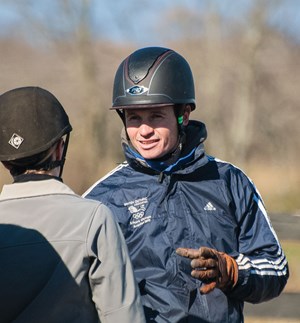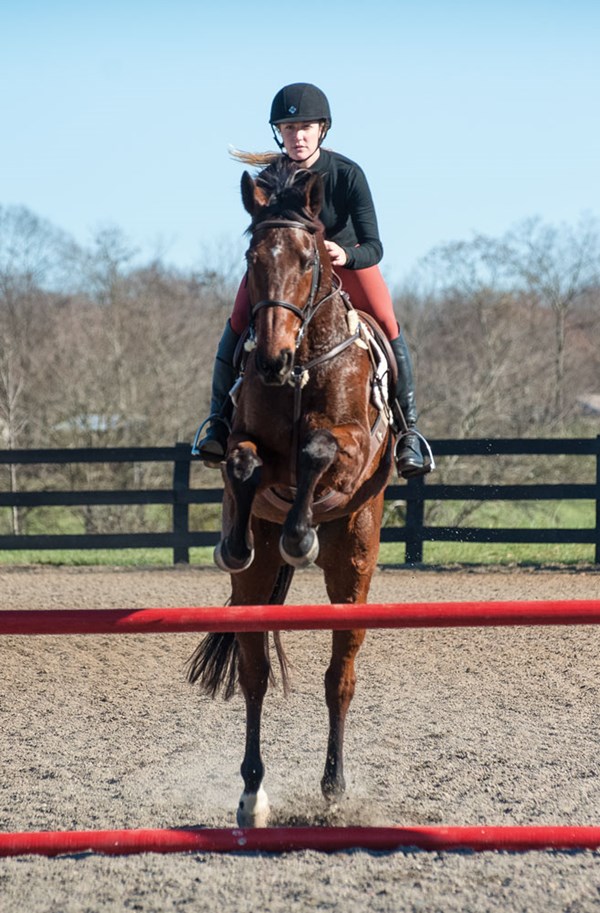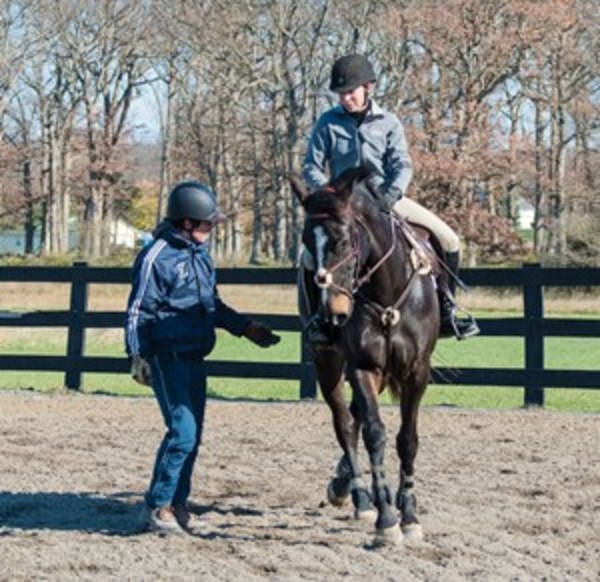 A big horse with a quiet way of going, Jayvyn was reluctant to go forward, so Francis Whittington told rider Carolyn Rice to use the show jumps—“that helps get the brain thinking and the body working.” | Leslie Threlkeld
A big horse with a quiet way of going, Jayvyn was reluctant to go forward, so Francis Whittington told rider Carolyn Rice to use the show jumps—“that helps get the brain thinking and the body working.” | Leslie ThrelkeldGreat Britain’s four-star event rider Francis Whittington kept things simple at the fall clinic with three key components of riding that have become his mantra: rhythm, balance, control. The focus of this particular training session, nestled in the Blue Ridge Mountains of Virginia, was taking these basics a step further. Eventers from Starter through CCI** worked on getting their horses to reach under with the inside hind leg, teaching them to carry the weight on their hindquarters and lift their shoulders to be in better balance. The result: horses learning to think more for themselves instead of relying on the riders to hold them up.
 Francis, talking with Carolyn, takes the time to answer any questions riders may have, using anecdotes from his own experiences with horses. | Leslie Threlkeld
Francis, talking with Carolyn, takes the time to answer any questions riders may have, using anecdotes from his own experiences with horses. | Leslie ThrelkeldThe setting for the series of private lessons on a sunny November weekend was Hunt Club Farms in Berryville, Virginia. The bitter cold and howling wind on Saturday didn’t keep the smiles off the faces of riders, parents and auditors for the dressage and show-jumping sessions, who wrapped in horse blankets and hid from the wind gusts behind the walls of the covered ring. But they were treated to a lovely fall day for cross country on Sunday.
Throughout the clinic, Francis welcomed questions from riders as well as parents and auditors, whom he often invited to stand in the arena so they could hear what he was saying in exchange for help setting fences between rounds. Soft-spoken and encouraging, Francis paired each correction with a compliment, leading to a relaxed and cheerful atmosphere.
Carry the Weight Behind
Horses who are heavy on the forehand can receive low marks in dressage, have rails down and refuse while jumping and develop a heavy contact that quickly exhausts riders. Before they can lighten their front ends, however, they must learn to shift their weight to their hindquarters, which is the engine that lifts horse and rider together and propels them forward. At all levels, Francis expected the horse to carry his own weight on his hind end and encouraged the rider to let the horse think for himself.
During flatwork, lower-level riders practiced 10- to 15-meter circles in good rhythm to get the horses stepping under themselves with the inside hind leg. As the riders worked, Francis reminded them to keep the inside hand up so that the pressure was on the corners of the horses’ mouths rather than the bars. He also stressed that riders have to be balanced if they want to help the horses stay in balance, so he adjusted some of their stirrups, shortening many of them, to facilitate a better balance in the irons.
Francis, however, changed the work depending on the horse. A tense horse, such as Kelsey Briggs’ Thoroughbred, The Gentleman Pirate, may not benefit from collection early on in the work. The gelding began with tension in his neck and a short step, so Francis had Kelsey send him more forward and lengthen his stride behind so he could stretch his neck out and relax. Only then did Kelsey use the half-halt to balance Pirate back and get him to sit, lighten his shoulder and carry himself more. Then they rode very small circles, almost canter pirouettes, to get the horse to step under. Kelsey was to turn by half-halting with her seat and turning her body, keeping her hands quiet, so that Pirate had to do the work himself instead of leaning on her hands.
Francis used a different strategy with Carolyn Rice’s 6-year-old Belgian Warmblood Jayvyn, a big horse with a quiet way of going. He was reluctant to travel forward and looked for a lot of support from Carolyn. To encourage the horse to carry himself, Francis used a jumping exercise on a circle and courses with frequent changes of direction. “Sometimes with a horse like that, just plain jumping or dressage isn’t right,” he said. “Using the show jumps to help you with your schooling, that helps get the brain thinking and the body working.”
They began by cantering circles over a single crossrail in each direction, allowing the jump to help teach the horse to engage his hind leg without the rider having to kick. They went on to ride an oxer on a circle and then added a vertical on a parallel line to the oxer so that there was a jump on each half of the circle. Eventually they incorporated some course work, riding a 20-meter circle over a single jump and then going straight to a related distance, all while keeping the rhythm and letting Jayvyn take some responsibility to keep his own balance.
For a higher-level horse and rider, the jumping exercises got a little more involved. Kelsey and Pirate, who are planning to move up to Advanced in the near future, jumped three fences parallel across the arena on a figure eight (see the diagram, page 40). Pirate’s tendency was to lean on the outside rein, baiting Kelsey to support him. The solution was to give him the outside rein and make him carry himself. This resulted in a few awkward fences at first, but when Pirate sat back and balanced himself, his jump got straighter and his shape was better.
 The Gentleman Pirate started the lesson holding tension in his neck. | Leslie Threlkeld
The Gentleman Pirate started the lesson holding tension in his neck. | Leslie Threlkeld First Francis wanted Kelsey Briggs to ride him forward, lengthening his step behind and allowing him to stretch over his topline. Only then did they ask him to sit and carry himself. | Leslie Threlkeld
First Francis wanted Kelsey Briggs to ride him forward, lengthening his step behind and allowing him to stretch over his topline. Only then did they ask him to sit and carry himself. | Leslie Threlkeld Francis had the more advanced horses and riders jump a figure eight over three fences parallel across the arena. The work encouraged the horses to shift their weight behind.
Francis had the more advanced horses and riders jump a figure eight over three fences parallel across the arena. The work encouraged the horses to shift their weight behind. Working over fences off a turn, Kelsey asked Pirate to sit all the way to the base of the jump without supporting him on the outside rein. There were a few awkward fences at first as Pirate looked for support, but his shape improved as he took responsibility for his own balance. | Leslie Threlkeld
Working over fences off a turn, Kelsey asked Pirate to sit all the way to the base of the jump without supporting him on the outside rein. There were a few awkward fences at first as Pirate looked for support, but his shape improved as he took responsibility for his own balance. | Leslie ThrelkeldLift the Neck and Shoulder
Once the horse is carrying the weight on his hindquarters, the neck and shoulder can come up, lightening the front end and making it easier for the horse to perform in a good balance.
Ashton Wildfire, a 5-year-old Belgian/ Warmblood-cross, owned and bred by Sheryl King, was another quiet type, but when he ran out at an oxer, Francis explained, “He’s a young horse, quite a big horse, and heavy on his front end. With horses like that the most important thing is to get them off their front end. To do that we’ve got to get them to sit on the hind leg so the shoulder can become lighter. From there you can improve the rest of the work, make them lighter in the contact so they are not so heavy and not so reliant on us to hold them up. If they are heavy on that contact and on the hand, then they’re going to be heavy over the fence, heavy in the shoulder, heavy in the turning and slow off the leg.”
Rider Travis Smith did some of the same turning exercises over fences that others practiced but with extra canter circles added between fences to make Ashton sit on his hind end and lift his shoulder. They went from the ring to the cross country, and Travis kept focusing on encouraging the horse to sit on his hind end and lift his shoulder before the fences.
Francis stressed that with a young horse who is on the heavier side physically, you have to resist asking too much too soon. “It takes a lot longer with those big ones. They have to find their own feet and develop so they can then become balanced. [Ashton’s] big issue is balance, but he’s going to take a long time to grow into that.”
 Ashton Wildfire is a little strung out behind and low in his shoulder on the first attempt at the oxer. | Leslie Threlkeld
Ashton Wildfire is a little strung out behind and low in his shoulder on the first attempt at the oxer. | Leslie Threlkeld Francis helped rider Travis Smith get the 5-year-old Belgian/ Warmblood-cross to sit on his hindquarters and lift his shoulders. The overall shape is better in the second jump. | Leslie Threlkeld
Francis helped rider Travis Smith get the 5-year-old Belgian/ Warmblood-cross to sit on his hindquarters and lift his shoulders. The overall shape is better in the second jump. | Leslie ThrelkeldTraining and Conditioning
 Ann Preston Campbell drove from North Carolina to Northern Virginia to ride with Francis on a borrowed horse, Autumn Zack Taylor’s Monty. Ann rode with Francis the following weekend in North Carolina as well. | Leslie Threlkeld
Ann Preston Campbell drove from North Carolina to Northern Virginia to ride with Francis on a borrowed horse, Autumn Zack Taylor’s Monty. Ann rode with Francis the following weekend in North Carolina as well. | Leslie ThrelkeldThe major changes in a horse’s and rider’s development don’t happen at a clinic, Francis said. “Here we’re assessing and providing tools, and you’re making the changes at home.
“We put a lot of emphasis on doing dressage, doing show jumping, doing cross country. What we should be looking to do is general training and conditioning of the horses so that they’re able to carry and support themselves,” he added. “When we’re making a turn around to a fence, we should be focusing just on making that balanced turn and maintaining the rhythm, which gives us the control. If we can put the responsibility on the horses to be in that self-carriage, to look after themselves so that we’re not having to do that, it will improve the type of canter we have when we get to the fence and improve the work that we have when we’re actually schooling jumping or competing.”
In his own career, Francis said this year especially he has realized that you have to train the whole horse, which takes time. “I’ve got to train more developed horses that have the freedom, elasticity and strength to carry themselves, cooperate and perform to the best of their abilities.”
With his horses, Francis focuses on developing relaxation and flexibility early so that they are better able to strengthen their bodies and carry themselves without tension as well as stretch and bend. “In the same way that any other normal athlete would be, you’ve got to have the strength to work but you’ve also got to have the elasticity there,” he said. “That will help with the training that will help with competition. Your jumping, dressage and cross-country horse will have the strength, stability and elasticity to answer all the questions that you’re asking of him.”
Have Fun and Be Confident
 Francis works with Carolyn Rice to get 6-year-old Belgian Warmblood Jayvyn to move off her leg and step under with the inside hind. | Leslie Threlkeld
Francis works with Carolyn Rice to get 6-year-old Belgian Warmblood Jayvyn to move off her leg and step under with the inside hind. | Leslie ThrelkeldIn the last three years, Kelsey Briggs has organized a clinic with Francis either in Virginia or at her home base near Charlotte, North Carolina, with the weather being the biggest obstacle. The first year there was an ice storm, the second it poured down rain and this time a frigid cold wind was blowing. Through it all, however, students keep coming back. Two riders even drove up from North Carolina to Virginia to ride with Francis on borrowed horses.
“We’ve got to have fun. It is about the journey. It’s not always just about where you get to at the end,” Francis said. “We all have different goals for what we want to achieve with riding, but one thing that is important is it’s got to be fun and enjoyable. If it’s fun and enjoyable, your brain will absorb more information.”
It is clear through his teaching style that Francis wants his students to finish a lesson having grown in confidence and leave knowing they are capable of more than they realized. One young woman on a new horse started over crossrails in the arena and finished jumping a Beginner Novice cross-country course with an ear-to-ear grin.
Focusing on the basic principles of rhythm, balance and control keeps the work simple and builds a foundation of training and conditioning at home that will translate to competing or whatever other goal a rider has. “For people who aren’t doing it professionally, part of their enjoyment is being able to go out and be confident on the horse,” Francis said. “If we can make them confident and happy, they’ll enjoy it more and learn more. It’s the same for green riders and horses up to experienced riders and horses.”
My Turn: StopWorking So Hard
 Leslie Threlkeld and Bailey | © The Carolinas Equestrian Magazine
Leslie Threlkeld and Bailey | © The Carolinas Equestrian MagazineOne week after teaching in Virginia, Francis traveled to North Carolina for another weekend of lessons, where I was fortunate to have the opportunity to ride with him. With the advantage of previously auditing a number of lessons and therefore having an idea of his favorite exercises, you bet I practiced jumping a single fence on a circle and three jumps on a serpentine ahead of time. I rode my mom’s foxhunter, Bailey, a 16-year-old Quarter Horse I competed to the Novice level when we were both youngsters. Bailey’s nickname is Potato because he’s built like a russet potato with carrot sticks for legs. He’s a bit on the forehand and wings like a butterfly-stroke champion swimmer, but he has a heart of gold and absolutely loves his job.
My goals during our private show-jumping lesson with Francis were specific: to feel confident jumping bigger fences and to take home exercises that will ultimately be beneficial for my mom to apply to her hunting and eventing career with Bailey. I have evented through the Preliminary level, but for the last eight years I’ve been riding young and inexperienced horses over small courses or not riding at all. It is remarkable how your eye for bigger fences diminishes over time and your confidence along with it. However, I know Bailey is capable, so it was simply a situation where I had to trust myself, my horse and my instructor and just do it.
To begin, Francis had us canter circles over raised cavalletti to help Bailey step under more with his inside hind leg and lift his shoulder. This exercise also encouraged him to pick up the elusive left lead when landing on a consistent left-handed turn. During several show-jumping rounds that followed, my job was to balance Bailey to keep him from falling on his shoulder while traveling forward in a good rhythm—a fine line. We didn’t always find the left lead when we needed it, but I was encouraged to carry on with the counter-canter rather than disrupt the rhythm with a simple change. With proper training and conditioning at home, Francis said, the correct lead would become easier to achieve. My homework is strengthening Bailey’s hind end by asking him to step under more and carry himself. We will be doing lots of spiraling in and out on the circle as well as lengthening and shortening the stride.
The course we practiced consisted of related distances, bending lines, s-turns and rollbacks. There was plenty to do, and as Francis gradually raised the fences to near Preliminary height, he reminded me that the principles of rhythm, balance and control apply at all levels. Focus on the recipe, he said, not the cake. As the fences got bigger, Bailey’s jump got better, but I became increasingly concerned about finding the perfect distance. I buried him to more than one huge fence and he jumped anyway (bless him), but during our final round I decided to quit working so hard. I allowed him to maintain a rhythm and helped balance him through the turns, then waited for the distances to find us.—Leslie Threlkeld
This article originally appeared in the March 2016 issue of Practical Horseman.










